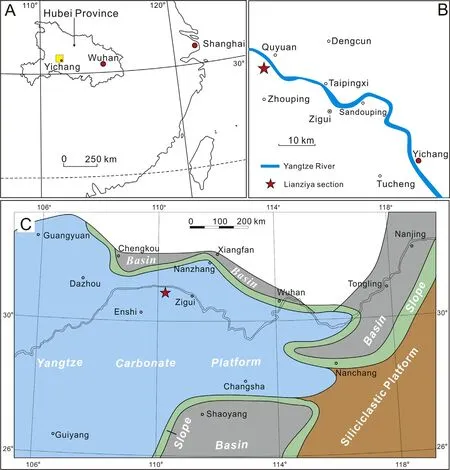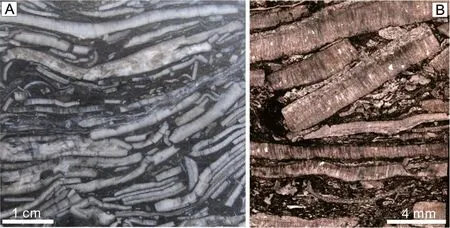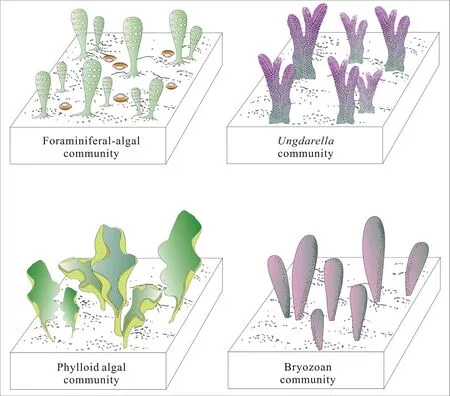Evolution of sedimentary facies and fossil communities in the Middle Permian Maokou Formation in Zigui County,Hubei Province,South China
Ke-Yu Zhu,Tan Wang,Zhi-Xing Yi,Yong-Biao Wang
State Key Laboratory of Geological Processes and Mineral Resources,School of Earth Sciences,China University of Geosciences,Wuhan 430074,Hubei Province,China
Abstract A geological event that happened at the end of the Middle Permian resulted in different levels of erosion in a shallow-water platform of South China,which led to diverse geological records in different sections.The Lianziya section in western Hubei Province of South China has a well-exposed stratigraphic sequence of the late Middle Permian rocks with abundant fossils and sedimentary facies types,providing new evidences for understanding the evolution of marine biota and environment in the late Middle Permian.Our study shows that four fossil communities can be recognized with the change of sedimentary facies in the late Middle Permian:Foraminiferal—algal community,phylloid algal community,bryozoan community and Ungdarella community.The foraminiferal—algal community is dominated by fusulinids and calcareous algae,but was soon replaced by the phylloid algal community.With an increase of terrestrial input,the phylloid algal community was again replaced by the bryozoan community.Near the end of the Middle Permian,with a decrease of terrestrial input,the bryozoan fossil community disappeared while the Ungdarella community became dominant.A 10 cm-thick weathered crust occurred at the top of the Middle Permian limestone,marking a large amplitude fall in sea-level and the beginning of a terrestrial erosion stage.The sedimentary facies and fossil community changes in the Lianziya section indicates that the Middle Permian crisis was a gradual process while the sea-level fall mainly occurred in the latest Middle Permian.
Keywords Fossil community,Sedimentary facies,Middle Permian,Guadalupian,Capitanian—Wuchiapingian,Zigui County,Hubei Province
1. Introduction
Although the end-Permian biotic crisis was considered to be the most severe mass extinction in the Phanerozoic(Erwin,1993;Knaust,2010;Knoll et al.,2007;Payne and Clapham,2012),some researchers have recently revealed that the biotic turnover occurring at the end of the Middle Permian(Guadalupian)might be the prelude of the former one(Stanley and Yang,1994;Xie et al.,2017).There are different explanations with respect to the causes and mechanisms of this extinction,including Kamura Cooling(Isozaki and Aljinovic,2009;Isozaki et al.,2007),Emeishan massive eruption(Ali et al.,2005;Lo et al.,2002;Zhou et al.,2002)and global regression(Erwin,2006;Jin et al.,1994a,1994b;Newell,1967).
In South China,previous work has focused mainly on the Middle Permian strata and eruption intervals in the areas near the Emeishan Large Igneous Province(ELIP)(Ali et al.,2010;Courtillot,1999;Sun et al.,2010;Wang et al.,2014;Wignall et al.,2009a,2009b;Zhou et al.,2002).Though the ELIP is generally the key region for the research of this Middle Permian geological event,work in other areas in South China will undoubtedly provide more information about the biotic and sedimentary response.
Previous researches have shown that the geological event at the end of the Middle Permian has different records in different palaeogeographic settings of South China.In most shallow-water carbonate platforms,a widespread parallel disconformity is recorded between the Middle Permian and the Upper Permian(Hallam and Wignall,1997,1999;Jin et al.,1994a,1994b,1995)and the presence of a weathered crust indicates a large-scale sea-level fall associated with this geological event.Traditionally,this disconformity has long been considered representing the Dongwu Tectonic Movement(DTM)that resulted in the Late Capitanian biotic crisis(Cao et al.,2013;Li et al.,2011).However,as a completely different response to the DTM,sedimentary facies changes from bioclastic limestone(Maokou Formation)to radiolarian chert(Gufeng Formation)in some basinal sections along the northern margin of the Yangtze Platform(Kametaka et al.,2005;Zhu et al.,2013)indicate a significant sea-level rise at the end of the Late Guadalupian.Different sea-level changes in various palaeogeographic settings would surely lead to a different evolution history both in sedimentary facies and fossil communities(Gallagher and Somerville,1997,2003;Gallagher et al.,2006).For this reason,it is necessary to obtain more geological evidence from various sections in order to fully understand the nature and process of the geological event that happened at the end of the Middle Permian.Here,we take the Lianziya section in Zigui County of Hubei Province as an example to analyze the geological records of the Middle Permian event in the middle Yangtze region which is far from the ELIP.
2. Geological background
Lianziya section is in the west of Hubei Province(Fig.1A and B).This area was palaeogeographically located in the north of the Yangtze Platform(Fig.1C).The sedimentary facies during the Middle Permian Capitanian can be easily distinguished in South China.The Maokou Formation extends over the central and western regions and is characterized by shallow-water carbonate sediments with abundant fossils,such as calcareous algae,bryozoans,brachiopods,fusulinids,and corals.In the northern and southern basins,the synchronous Gufeng Formation and the Dangchong Formation comprise siliceous deposits and the fossils therein are mainly planktonic radiolarians and nektonic ammonoids with rare benthos.The lower part of the Maokou Formation is mainly composed of bioclastic limestone with much siliceous nodules but the siliceous component decreases in the upper part with the increase of fossils.Our work focused on the evolution of sedimentary facies and fossil communities from the upper part of the Maokou Formation to the base of the Late Permian Wujiaping Formation.
The upper part of the Maokou Formation contains four sedimentary units(Fig.2).The bottom unit is a 4 m-thick limestone with abundant fusulinids,other foraminifers,and calcareous algae.The second unit comprises a 1 m-thick phylloid algal limestone.Following the end of phylloid limestone deposition,the terrestrial input increased,leading to the formation of a 4 m-thick argillaceous limestone in unit 3 that is rich in bryozoans.The fourth unit is represented by a 3 m-thick pure limestone with considerable amount of the alga Ungdarella.The top of the Maokou Formation is covered by a 10 cm-thick palaeo-weathered crust(Fig.3),indicating a significant sea-level fall near the end of the Capitanian.
From the start of the Upper Permian,a 1.3 m-thick mudstone and sandstone unit was first deposited,followed by thin-bedded limestone rich in siliceous nodules,marking the onset of a new transgression.

Fig.1 A—B— Location of the Lianziya section in Zigui County,Hubei Province,South China;B is the enlarged area of the yellow box in A;C—Palaeogeographic map of the Middle Permian Capitanian in the north of South China(modified from Feng et al.,1996).
3. Evolution of sedimentary facies and fossil communities
Field investigation and microfacies analysis show that evolutional history of sedimentary facies and fossil communities during the late depositional period of the Maokou Formation can be divided into the following four stages(Figs.4—8).
3.1. Foraminiferal—algal community in normal shallow marine shelf
In the Lianziya section,the lower part of the Maokou Formation(from 0 to 1.2 m above the base of logged section)is mainly comprised of limestone with cherts,but the abundance of fossils increases quickly in the upper part of this formation with the decrease of chert within the limestone.The space between bioclastic grains was cemented by calcite spar,indicating stronger hydrodynamic conditions.Therefore,some fossils should have been reworked.However,the fossils are mostly well preserved,and thus could reasonably represent the components of the local fossil community.
Fossil identification shows that this community mainly consists of fusulinids,non-fusulinid foraminifers and calcareous algae(Fig.4).The larger size Neoschwagerina and Verbeekina can commonly be seen both in the field and in thin section,confirming the age of the section as the Middle Permian Capitanian.Non-fusulinid foraminifersinclude Globivalvulina,Robuloides and Pachyphloia.The green alga Mizzia is the most common species of calcareous algae.Abundant fusulinid fossils in the Lianziya section are quite similar to those in other regions of South China(Liu et al.,2000;Yang et al.,1999a,1999b;Zhong et al.,2014),which is the most typical fossil community in the Maokou Formation that formed in a normal shallow-water environment during the Capitanian Age.

Fig.2 Stratigraphic sequence and fossil community evolution of the upper part of the Middle Permian Maokou Formation in Lianziya section.The black arrows represent sample locations.
3.2. Phylloid algal community in quiet subtidal zone
A 1 m-thick limestone enriched in phylloid algae formed at the top of the underlying limestone rich in fusulinids and algae.Eugonophyllum was identified as the dominant genus in this fossil community with a small amount of miniaturized foraminifers preserved in spaces between the phylloids(Fig.5).The phylloid algae are platy in shape,and the average thickness of the phylloid plate is about 2.5 mm.Influenced by later diagenesis,most of the phylloid plates have apparently been recrystallized.The space between phylloid algae was filled by micrite matrix,which may be interpreted as the baffling effect of phylloid algae.
Because of the barrier of the large thallus,the extreme abundance of the phylloid algae may prevent other photosynthetic organisms from getting enough light,which may be the key reason for the scarcity of other calcareous algae in this fossil community.Besides,it was reported that Halimeda,one of the distant relatives of phylloid algae,would produce toxic secondary metabolite diterpenes for defending themselves from fish grazing in modern marine environment(Schupp and Paul,1994).It may also be true for phylloid Eugonophyllum,based on the fact that their thallus was well preserved and never destroyed by animals.All these above reasons might have resulted in the low biodiversity in this community.

Fig.3 Parallel disconformity between the Middle Permian Maokou Formation and the Upper Permian Wujiaping Formation.A shows the sedimentary sequence near the boundary between the two Formations;B is the enlarged area of the white box in A,showing the fresh outcrop of the weathered crust.
3.3. Bryozoan community in weak hydrodynamic environment
This fossil community is characterized by many bryozoan fossils,including Stenopora and Stenodiscus(Fig.6),with other organisms mainly consisting of nonfusulinid foraminifers.Compared with the phylloid algal community,the bryozoan community should have lived in a weaker(low energy,quiet water)hydrodynamic environment due to the presence of much micrite matrix.
It is noteworthy that the micrite matrix of this bryozoan wackestone contains abundant silt-size quartz grains,indicating a detrital influx from an external sediment source during this period.Although the eruption of Emeishan basalt in South China may provide detrital materials,the products lack quartz particles.Therefore,quartz grains in the matrix are interpreted to have derived from continental weathering around local regions.Previous research suggests a significant tectonic uplift both in the west of South China and in Cathysia located in the east(Feng et al.,1993,1996).Accretion of land area provided large amount of terrigenous debris into the marine environment.Terrigenous matter input is commonly considered harmful to most benthic animals(Algeo and Twitchett,2010).However,the flourishing of bryozoans indicates that they have a strong ability to survive in an environment affected by terrigenous input.
3.4. Micritized grainstone and Ungdarella community
The top part of the Maokou Formation is a 3 m-thick interval of light-grey pure limestone.Thin section examination shows the limestone is composed of bioclastic grainstone(Fig.7A).The bioclastics include a variety of minor and micritized non-fusulinid foraminiferans,ostracods and red algal fragments.Absence of micrite matrix points to a strong,high-energy hydrodynamic shallow-water environment.Widespread micritization of fossil grains suggests that the sediments might have been even exposed in the upper intertidal or supratidal zone.Micritization is generally caused by microbial algal(possibly cyanobacterial)boring in the surface of bioclasts.Plenty of tiny borings make the original carbonate grains become powdery,thus appearing as black color.Based on the above analysis,we deduce that the bioclastic limestone must have been deposited in quite shallow water depths duringthegreatregression at the end of the Capitanian.
Although most fossils have become fragmented and micritized,the occurrence of so much red alga Ungdarella(Fig.7B and C)indicates a completely different community began to inhabit at the end of the Maokou Formation,where the Ungdarella developed as the dominant taxon in the ecosystem.Thus,Ungdarella may well represent the characteristic of this community that consists of miniaturized nonfusulinid foraminiferans, ostracods, as well as Ungdarella.
4. Discussion

Fig.4 Foraminiferal—algal community.A — Packstone with algae and foraminifers.The black area represents micritic matrix and the yellow arrow points to foraminifer Pachyphloia;B—Grainstone with algae and foraminifers.The green arrow points to the calcareous alga Mizzia and the yellow arrow points to an unidentified foraminifer;C—Fusulinid Neoschwagerina;D—Fusulinid Verbeekina.
There are plenty of controversies regarding the reason for the end-Guadalupian event and biotic extinction(Jin et al.,1994a;Stanley and Yang,1994).Due to the different biotic response to this geological event in various marine environments,it is necessary to obtain more information from the literature in various sections in order to fully understand the nature and detailed process of the biotic extinction associated with the geological event near the end of the Middle Permian.

Fig.5 Phylloid algae of platy Eugonophyllum.The interspace between the fossil skeletons was filled with micritic matrix(black area).A small amount of miniaturized foraminifers can occasionally be seen.A—Photo of polished sample showing well-preserved thallus of phylloid algae;B—Thin section photo under microscope revealing recrystallized wall fabric composed of needlelike calcite minerals.

Fig.6 Bryozoans in the argillaceous limestone with abundant fine silt-sized quartz detritus,some of which are marked with yellow arrows in thin section photo.A—A longitudinal section;B—A transverse section;C—A tangential section of ramose bryozoans.

Fig.7 A—Bioclastic grainstone composed of micritized fossil fragments.Yellow arrows indicate one of the fragments that was micritized on both sides of the shell;B—C — Ungdarella fossils indicated with green arrows show bifurcation of thallus that can commonly be seen within the top part of the Maokou Formation.
Lianziya section clearly recorded the evolution of fossil communities in shallow marine environment near the end of the Middle Permian.From the record in the Lianziya section,the fusulinid limestone of the Maokou Formation possesses the highest fossil biodiversity,thus it represents a stage with favorable shallow marine environment for organisms.But the sedimentary facies and fossil assemblage began to change quickly near the end of the Middle Permian,with the ecosystem periodically being dominated by phylloid algal community,then a bryozoan community and finally the Ungdarella community.Therefore,the extinction event at the end of the Middle Permian cannot be regarded as a simple disappearance of species.Instead,it is a succession of community replacement associated with the evolution of marine ecology including the sea-level fluctuation and siliciclastic input(Fig.8).Evidence from the Lianziya section indicatesthatthe evolution of the fossil community and the marine environment is a gradual process rather than a dramatic turnover.However,different organisms exhibited different adaptability to the ecological change.Fusulinids tended to suffer a bigger loss and decreased more severely while the new algal taxa,such as phylloid algae and the red alga Ungdarella,began to occupy the ecological space successively.Although the detailed process still remains unknown,it can surely be confirmed that the extinction event should have happened long before the end of the Capitanian,as recorded in the Lianziya section.This conclusion is supported by Bond et al.(2010),who made the point that the extinction event is restricted in the Middle Capitanian although some other researchers put the timing of the extinction event at the end of the Capitanian(Tian et al.,2016;Zhao et al.,2016).
It is a complex issue as for the cause and mechanism of the end-Guadalupian event and biotic extinction.Undoubtedly,the occurrence of ELIPin the Middle Permian is one of the key factors.The marine environment and biota could be affected by various volcanism-associated events,such as the input of volcanic ash(Jerram et al.,2015),a regression resulting from the uplift of ELIP(Kofukuda et al.,2014),as well as the increasing terrigenous input(Li et al.,1999).However,siliceous nodules related to volcanic ash(Shi et al.,2016)are mainly found in the lower part of the Maokou Formation in the Lianziya section but their abundance decreases in the upper part.However,the extinction event mainly happened near the end of the Maokou Formation,thus there seems to be no evidence for the relationship between the biotic extinction and the volcanic matter input,at least in the study section.Indeed,the increasing input of terrigenous matter led to the decline of fusulinids and the flourishing of phylloid algae and bryozoans.Nevertheless,pure limestone occurred again at the top of the Maokou Formation,indicating the decrease ofter rigenous input.However,the decrease of terrigenous input did not prevent marine organisms from declining,implying no relationship between biotic extinction and terrigenous input at the end of the Middle Permian.Instead,the weathered crust at the top of the Maokou Formation is direct evidence that a large-scale sea-level fall could obviously account for the eclipse of shallow marine benthos.

Fig.8 Reconstruction of fossil communities at the end of the Middle Permian in Lianziya section,Hubei Province,South China.
5. Conclusions
Microfacies analysis shows that the evolution of sedimentary facies and fossil communities in the upper part of the Maokou Formation can be divided into four stages,respectively as the foraminiferal—algal community,phylloid algal community,bryozoan community and Ungdarella community.
The evolution of fossil communities near the end of the Middle Permian exhibits a trend from high biodiversity to lower biodiversity,although the abundance may remain unchanged.
The existence of abundant silt-size quartz grains in the bryozoan wackestone indicates increased detrital influx from continental weathering,rather than the eruption of the Emeishan basalt in the west of South China.The flourishing of bryozoans in this condition implies that they have strong adaptability to survive in the marine environment affected by terrigenous input.
Lack of terrigenous sediments within the Ungdarella limestone at the end of the Maokou Formation and the occurrence of a weathered crust on the top,indicate that it is the end-Capitanian great regression rather than the detrital input that accounts for the extinction of marine benthos in the study area.
Acknowledgements
The authors thank Ian D.Somerville,Tadeusz Peryt and Xiao-Ying Shi for their detailed revisions and helpful suggestions that make significant improvements to the paper.Guo-Shan Li and Bao-Zhu Deng are appreciated for their contribution to the field work.This study was supported by the National Natural Science Foundation of China(Grants No.41572001 and No.41730320).
 Journal of Palaeogeography2018年1期
Journal of Palaeogeography2018年1期
- Journal of Palaeogeography的其它文章
- Late Triassic sauropodomorph and Middle Jurassic theropod tracks from the Xichang Basin,Sichuan Province,southwestern China:First report of the ichnogenus Carmelopodus
- Trace fossils of an amalgamated storm-bed succession from the Jurassic of the Kachchh Basin,India:The significance of time-averaging in ichnology
- Oxygenation in carbonate microbialites and associated facies after the end-Permian mass extinction:Problems and potential solutions
- A redescription of the ichnospecies Koreanaornis anhuiensis(Aves)from the Lower Cretaceous Qiuzhuang Formation at Mingguang city,Anhui Province,China
- Geologic-seismic models,prediction of shallow-water lacustrine delta sandbody and hydrocarbon potential in the Late Miocene,Huanghekou Sag,Bohai Bay Basin,northern China
- Deeply concealed half-graben at the SW margin of the East European Craton(SE Poland)—Evidence for Neoproterozoic rifting prior to the break-up of Rodinia
